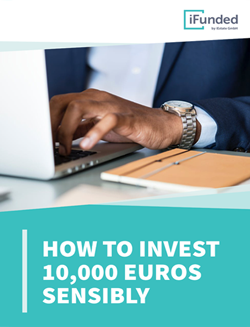With this checklist Crowd-investors can now assess the risk of a real estate investment

Generally, investors should not only pay attention to the return on an investment. Much more significant is the risk-adjusted return. Investment A with a return of 7% is much less attractive in comparison to investment B with a 5% return, if the risk of investment A is twice as high for example. But for this the investor must first have an idea of how high the risk actually is.
Risk checklist with 9 criteria
To determine the risk of a real estate investment, investors should consider nine criteria. For this iFunded has created a checklist by which investors can determine the risk themselves. This checklist is naturally also used by iFunded to determine the risk categories for each individual real estate project – from A for low risk to E for high risk.
Criterion 1: Debt ratio
With increasing debt ratio, the risk of a real estate investment also increases. The risk is that interest rates rise again and increase capital costs for example. In the event of poor market developments, banks can demand additional securities from the project developer, should he not be able to provide additional securities, the loan agreements issued by the bank can immediately become due. It may also be that the rental income from the property decreases, possibly leading to no longer being able to pay the interest owed to the bank. Since real estate properties are usually always co-financed through bank loans, a debt ratio of up to 49% is acceptable. However, from a rate of 70% caution is advised.
Criterion 2: Equity ratio
A high equity ratio by the project developer is a good sign. This indicates that the developer is confident on the success of the real estate project and ready to tie up capital himself. Especially experienced real estate developers put emphasis on an appropriate equity ratio. An equity ratio of 30% can reduce the risk of an investor.
Criterion 3: Macro location
Location, location, location – the location quite decisively influences the success of a real estate project. In cities such as Berlin, Hamburg or Munich, the demand for housing is very strong due to the increase in immigration. The risk is even manageable in smaller regional capitals. It starts becoming critical in small towns that have less than 100,000 inhabitants.
Criterion 4: Micro location
In addition to the macro location, the micro-location is naturally also very important. An inner-city location with easy access therefore leads to a lower risk than a suburban location with no connection to the local public transport.
Criterion 5: Property occupancy rate
A high occupancy rate of the property means that regular rental income can be obtained. If it is a new building project that the investors co-finance, there is of course no rental income. That is one reason why new building project generally involve greater risk than existing real estate properties.
Criterion 6: Number of tenants
The number of tenants also affects the risk of a property. For if the entire rental income is paid by only one tenant for example, the default risk is obviously much higher than if there were five tenants. Residential properties such as apartment buildings often have more than ten tenants and therefore carry less risk. In office and commercial properties there are often far fewer tenants. Should the lease expire in one of these, it is questionable how quickly a new tenant can be found or whether it will come to a longer loss of rent, which would significantly affect the value of the commercial property. This also demonstrates the particular risk of new building projects which have no tenants.
Criterion 7: Development stage of the property
The risk also depends on the particular development stage of the property. An existing property without maintenance backlog has a very low risk. However, if the property is in a very bad condition and needs to be completely renovated, the risk is much higher. It is at its highest with new building projects which carry many risks, which do not exist for existing real estate properties. It can come to delays in the executions and completion of the project. For example, if regulatory approvals are not granted in time or not granted at all, or unexpected soil contamination is discovered it can delay the construction process.
Criterion 8: Experience of the issuer
The success of a real estate project depends to a large extent on the ability and experience of the project developer. It is therefore important for investors to know how high the total investment volume of the project developer in the respective market is. If the developer has already carried out projects worth more than 200 million euros, the investor can sleep more soundly than if the value is less than 50 million euros.
Criterion 9: Securities
Is there a personal guarantee by the developer? Is there a second-rank mortgage for the crowd as security? Are there profit transfer claims for investors? If these securities are provided, the investment risk is considerably lowered.
In the iFunded Risk Assessment List, each criterion has been deposited with risk points. The risk points for criteria one through nine are then added together. The fewer risk points the property has, the lower the risk. You can view the respective risk classes from the following table:

